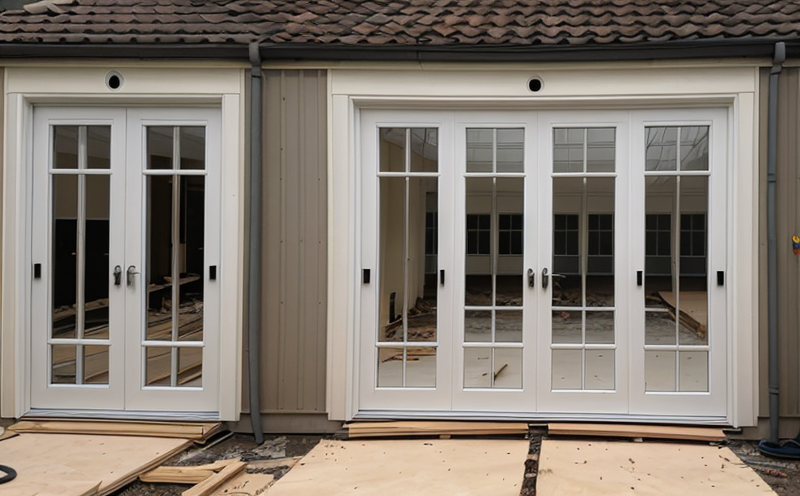Fire Endurance Testing of Steel Windows
In today's increasingly stringent fire safety regulations, ensuring that building components meet or exceed required standards is paramount. For steel windows, this involves subjecting them to rigorous testing protocols designed to assess their ability to maintain structural integrity and provide a barrier against the spread of flames during a fire emergency. This service focuses on evaluating the fire endurance characteristics of steel windows, ensuring compliance with international safety standards.
The fire endurance test is critical for several reasons. First, it helps in determining how long a window can withstand exposure to fire without failing. Second, it assesses the extent to which heat and flame spread through the window material before reaching the interior environment. Third, this testing ensures that windows comply with relevant regulations such as ISO 14693:2007 for steel doors and windows.
During the test, a standardized specimen of the steel window is placed in a furnace where it undergoes exposure to both heat and flame for a specified duration. The temperature inside the furnace is typically maintained at between 850°C and 950°C, which simulates real-world fire conditions. The test aims to evaluate not only the window's resistance to heat but also its ability to resist the spread of flames.
The testing process involves precise preparation of the window specimen. This includes ensuring that the window is free from any defects or imperfections that could compromise its performance during the test. Once prepared, the window is placed in a furnace for exposure to fire. The duration and temperature conditions are strictly controlled according to the specified standards.
Upon completion of the test, detailed measurements and observations are made to assess the integrity of the window. These include checking for any signs of structural damage or failure, such as cracking, deformation, or loss of flame resistance. The performance metrics are then compared against the required criteria to determine whether the window meets the necessary standards.
This testing is essential in ensuring that steel windows provide reliable fire protection, thereby contributing to a safer built environment. By adhering to these stringent tests and meeting relevant international standards, manufacturers can ensure their products meet regulatory requirements and contribute positively to public safety.
Scope and Methodology
| Parameter | Description |
|---|---|
| Test Specimen | A standardized specimen of the steel window to be tested. |
| Temperature Range | Between 850°C and 950°C, simulating real-world fire conditions. |
| Duration | Determined by specific standards or client requirements. |
| Environmental Conditions | In a controlled furnace environment to ensure consistent testing parameters. |
| Data Collection | Observations and measurements of structural integrity post-test. |
The scope of fire endurance testing for steel windows includes several key aspects. The test specimen is prepared according to standard procedures, ensuring that any defects are minimized. Once the window is placed in the furnace, it undergoes exposure to high temperatures and flames for a specified duration. Upon completion, detailed observations are made to assess the structural integrity and flame resistance of the window.
The methodology involves several critical steps. The first step is specimen preparation, which ensures that any defects or imperfections are minimized. This step is crucial as it directly impacts the outcome of the test. Following preparation, the window is placed in a furnace for exposure to fire conditions. The temperature and duration of this exposure are carefully controlled to ensure consistency and accuracy.
Upon completion of the test, detailed observations are made to assess the structural integrity of the window. This includes checking for any signs of damage or failure such as cracking or deformation. Data collection involves recording these observations and comparing them against the required performance metrics specified in relevant standards. The final step is reporting the results, which provides a comprehensive overview of the test’s outcome.
This rigorous testing process ensures that steel windows meet stringent fire safety standards. By adhering to these protocols, manufacturers can ensure their products provide reliable protection, contributing significantly to public safety and compliance with regulatory requirements.
Why Choose This Test
- Ensure Compliance: Meet stringent fire regulations and standards.
- Increase Safety: Provide reliable protection against fire spread.
- Enhance Reputation: Demonstrate commitment to quality and safety.
- Reduce Risks: Minimize potential legal and liability issues.
- Market Advantage: Gain a competitive edge in the market by meeting high standards.
- Customer Satisfaction: Meet client expectations for safe and reliable products.
The fire endurance test is an essential service that offers numerous benefits. By choosing this test, clients can ensure their steel windows comply with stringent fire regulations and standards. This not only enhances the safety of buildings but also improves reputation and customer satisfaction. Additionally, it reduces potential legal and liability risks associated with non-compliance.
Furthermore, meeting high standards through this service provides a significant market advantage. Consumers and stakeholders increasingly demand products that meet or exceed quality benchmarks. By choosing fire endurance testing, clients can demonstrate their commitment to quality and safety, thereby attracting more customers and building stronger relationships with partners and suppliers.
The test also ensures reliable protection against the spread of fire, which is critical in preventing casualties and property damage during emergencies. This reliability contributes to overall public safety, making it an indispensable service for any manufacturer or installer of steel windows.





